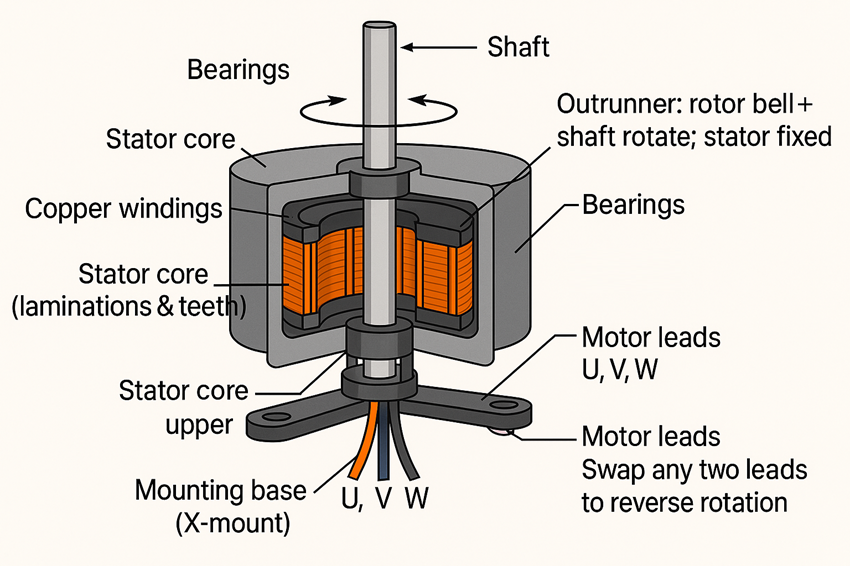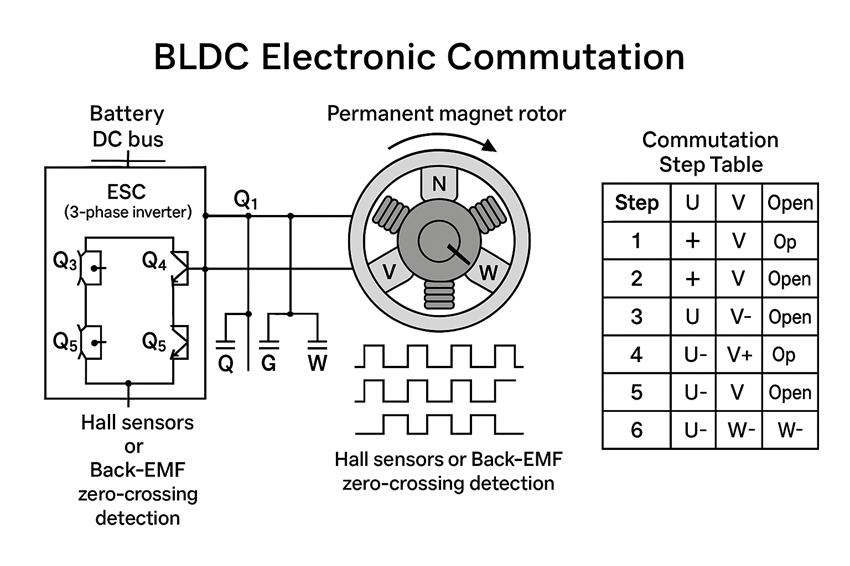In the entire power system of a drone,the motor plays a vital role.It is not only the"heart that propels the drone to take off"but also the core executive unit for achieving precise control and complex flight maneuvers.Whether it is a lightweight and agile aerial photography drone,a high-speed and nimble FPV racing drone,or a long-endurance large industrial drone,the performance of the motor directly determines the aircraft's thrust,response speed,stability,and flight time.
Currently,the vast majority of drones use brushless DC motors.Compared to traditional brushed motors,brushless motors are more efficient,have a longer lifespan,and offer more precise control,making them the standard configuration in the drone industry.Therefore,this article will focus on brushless drone motors,providing an in-depth analysis of their basic concepts,energy conversion principles,the role of flight controllers and electronic speed controllers,and their operational characteristics,all explained in the context of practical application scenarios.
At the same time,if you want a more systematic understanding of drone motor types,parameter analysis,and selection tips,you can refer to our Drone Motor Guide.
I.Structure and Advantages of Drone Brushless Motors
A brushless DC motor is a type of motor that uses electronic control to achieve commutation and is currently the mainstream power source for drones.
1. Basic Structure of a Brushless Motor
Stator Windings:Stationary coils that generate an electromagnetic field when energized.
Rotor with Permanent Magnets:Rotates under the influence of the magnetic field to output mechanical energy.
Bearings and Housing:Ensure the smooth rotation of the rotor and provide support and protection.
Compared to traditional brushed motors,the biggest difference in brushless motors is the absence of brushes and a mechanical commutator.The commutation process is handled by an Electronic Speed Controller(ESC),which avoids the energy loss and lifespan issues caused by brush friction.

2. Advantages of Brushless Motors
Higher Efficiency:Can output greater thrust with the same amount of electrical energy.
Longer Lifespan:No mechanical wear,essentially maintenance-free.
Faster Response:When combined with an ESC,it can achieve high-frequency,precise speed adjustments.
For these reasons,drone brushless motors have almost completely replaced brushed motors,becoming the standard configuration for aerial photography drones,FPV racing drones,and industrial-grade drones.The core of their working principle is the use of electronic commutation to create a rotating magnetic field,which drives the rotor to spin at high speeds,thereby generating thrust through the propeller.
II.Working Principle of Brushless Drone Motors
The operation of a drone brushless motor is essentially a process of step-by-step energy conversion:the battery provides DC electrical energy→electromagnetic induction generates torque→the rotor spins,driving the propeller→the propeller pushes air to create thrust.
1. The Principle of Electromagnetic Induction
When direct current,controlled by the ESC,flows into the stator windings,the windings generate a magnetic field.Because the stator windings are distributed in different phases around the motor,the ESC energizes the windings of different phases in sequence,creating a rotating magnetic field within the stator.
Role of the Stator:The copper wire windings generate an electromagnetic field when energized.
Role of the Rotor:The permanent magnets on the rotor are subjected to forces of attraction and repulsion from the magnetic field.
Torque Generation:The stator's magnetic field continuously changes direction,pushing the rotor to experience a constant force,thus producing stable torque.
This stage accomplishes the energy conversion from electrical energy→magnetic field→torque,which is the core physical principle of motor operation.
2. Driving the Rotor to Spin
Brushless motors typically use a three-phase winding system.When the ESC controls the three-phase currents to conduct alternately,a continuously rotating magnetic field is formed inside the stator.Driven by this rotating magnetic field,the rotor is forced to"follow"the direction of the field,achieving continuous rotation.
Three-Phase Current Alternation:Phase A→Phase B→Phase C,creating a rotating magnetic field.
Rotor Response:The magnetic poles on the rotor align with and are continuously pulled by the stator's magnetic field,completing the rotation.
Continuous Motion:As long as the current is supplied,the motor will maintain high-speed rotation.
Therefore,the"source of power"for a brushless motor lies in the precise switching of the three-phase currents.
3. The Generation of Thrust
The mechanical energy from the motor is transferred to the propeller through the output shaft,causing the propeller to spin at high speed.As the propeller rotates,it changes the direction of airflow:
The propeller pushes air downwards,and the reaction force from the air pushes upwards,generating lift and thrust.
The amount of thrust depends on the motor's speed(RPM),the propeller's size,and its pitch.
The higher the RPM,the more significantly the air is accelerated,and the greater the thrust.
Thus,the entire chain can be simplified as:
Battery→ESC→Motor→Propeller→Thrust→Drone Flight
Now that we understand how the motor converts electrical energy into mechanical energy,we need to further explore how the motor achieves electronic commutation and position sensing,which is the key to the high efficiency of brushless motors.
III.Electronic Commutation and the Principle of Back-EMF in Drone Motors
In brushless motors,because there are no mechanical brushes and commutators,the commutation of current relies entirely on the Electronic Speed Controller(ESC).This process is known as Electronic Commutation.
1. The Mechanism of Electronic Commutation
Three-Phase Energizing Sequence:Brushless motors typically use three-phase windings.The ESC sequentially switches the conduction order of the A,B,and C phase currents to create a continuously rotating magnetic field.
Rotating Magnetic Field Pulls the Rotor:The permanent magnets on the rotor are continuously attracted and repelled by the stator's rotating magnetic field,generating continuous torque for stable rotation.
Precise Control:The core of electronic commutation is accurately determining the rotor's position and the timing for commutation.Otherwise,issues like jittering,loss of synchronization(desync),or even stalling can occur.

2. The Role of Back-Electromotive Force(Back-EMF)
When the rotor spins,a voltage is induced in the stator windings.This is the Back-Electromotive Force(Back-EMF).
Physical Origin:The rotor's magnetic field cuts through the stator windings,inducing a voltage.
Characteristics:The magnitude of the Back-EMF is directly proportional to the motor's speed,and its waveform can reflect the rotor's position.
Applications:
In sensorless motors,the ESC determines the rotor's position by detecting the zero-crossing point of the Back-EMF,which dictates the timing for commutation.
In sensored motors,Hall effect sensors directly provide position information,and Back-EMF can be used as a supplementary signal.
3. Sensored vs.Sensorless Drive
Sensored BLDC Drive:
Uses Hall effect sensors to monitor the rotor's position in real-time.
Advantages:Good low-speed performance and smooth startups.
Disadvantages:Sensors add cost and weight and can be damaged in harsh environments.
Sensorless BLDC Drive:
Determines the rotor's position by detecting the Back-EMF signal.
Advantages:Simple structure,low cost,and high reliability.
Disadvantages:Difficult to obtain a clear signal at low speeds or during startup,requiring special control algorithms.
IV.The Role of the Flight Controller and ESC in Motor Control
Although the brushless motor is the power source for a drone,it does not operate"autonomously."Instead,it relies on the precise coordination of the Flight Controller(FC)and the Electronic Speed Controller(ESC).The FC acts as the"brain"of the drone,responsible for calculating the required thrust distribution.The ESC is the"actuator,"converting signals into precise current control to drive the motor at high speeds.The two work in tandem to form the drone's power control system.
1. The Role of the Flight Controller(FC)
The FC is the most critical control unit of the drone.It does not directly control the motor speed but indirectly determines"how fast and in what way"each motor should spin by sending signals to the ESCs.
Sensor Fusion:The FC continuously collects data from sensors like the gyroscope,accelerometer,barometer,and GPS to determine the drone's attitude and position.
Control Algorithms:Using algorithms such as PID,it calculates the drone's attitude deviation in three-dimensional space and decides which motor's thrust needs to be increased or decreased.
Signal Output:The FC converts the calculation results into control signals and transmits them to each ESC,instructing the motors to adjust their speed.
In simple terms,the FC is the"decision-maker,"constantly thinking:Is the drone yawing?Do I need to increase the thrust of the left-side motors?
2. The Role of the Electronic Speed Controller(ESC)
The ESC is the bridge connecting the FC and the motor.It receives signals from the FC and translates them into the current control that the motor can use.
Commutation Control:The ESC controls the on/off sequence of the three-phase currents to ensure the rotor spins in the intended direction.
Speed Regulation:Based on the FC's commands,it precisely adjusts the current's frequency and duty cycle to control the motor's speed.
Protection Mechanisms:Most ESCs have built-in protection features,such as over-current protection,over-heat protection,and low-voltage protection,to prevent damage to the motor or battery.
Therefore,the ESC is the"executor."It makes no decisions but must faithfully and rapidly execute the commands from the FC.
3. The Synergy Between the FC and ESC
A drone's flight stability depends on the highly efficient cooperation between the FC and the ESCs:
The FC detects an attitude deviation(e.g.,the nose of the drone is pitching down).
Through calculations,the FC concludes that the thrust of the rear motors needs to be increased.
The FC sends a command to the ESCs corresponding to the rear motors.
The ESCs immediately adjust the three-phase currents,increasing the motor speed.
The motors drive the propellers to accelerate,increasing thrust and restoring the drone to a balanced state.
This closed-loop process typically runs at a frequency of milliseconds,with hundreds to thousands of updates per second,enabling the drone to maintain stable flight under disturbances like wind gusts or changes in payload.
V.Frequently Asked Questions(FAQ)
Q1:Why do drone motors typically use three phases instead of two or four?
A1:Three-phase motors strike the best balance between efficiency,cost,and control complexity.Two-phase motors have high torque ripple and low efficiency,while four-phase and higher-phase motors,though smoother,significantly increase the complexity and cost of the ESC.Therefore,the three-phase design has become the mainstream standard.
Q2:Can drone motors be used underwater or in high-humidity environments?
A2:Standard brushless motors are not fully waterproof.The ingress of water or moisture can lead to short circuits or corrosion.For use in high-humidity or underwater conditions,specially waterproof-coated motors or motors with a waterproof housing must be used,along with a waterproof ESC.
Q3:Why do motors produce a"whining"or"screeching"sound at high speeds?
A3:This sound is caused by electromagnetic vibrations that occur when the motor windings'magnetic fields switch frequently,interacting with the stator's iron core.It is also related to the PWM(Pulse Width Modulation)frequency of the ESC.Using an ESC with a higher PWM frequency can reduce this noise.
Q4:What is the significance of motor direction(counter-clockwise vs.clockwise)?
A4:Drones typically require motors to be installed in counter-rotating pairs to cancel out reactive torque and maintain the stability of the airframe.If the motors are spinning in the wrong direction,the drone may be unable to take off or may lose attitude control during flight.
Q5:Why do motors demagnetize over long periods of operation?
A5:Permanent magnets can lose some of their magnetic properties at high temperatures,a phenomenon known as demagnetization.This leads to a decrease in motor efficiency and a reduction in thrust.The solution is to use magnets with a higher temperature rating or to improve the motor's heat dissipation design.
Q6:Why do drone motors require a large current to start up?
A6:At the moment of starting from a standstill,the motor must overcome static friction and inertia while also rapidly establishing a magnetic field.Therefore,the starting current is typically much higher than the normal operating current.This is also why ESCs must have soft-start and current-limiting protection features.
Previous Post : Brushless Drone Motor Components and Structure Explained
